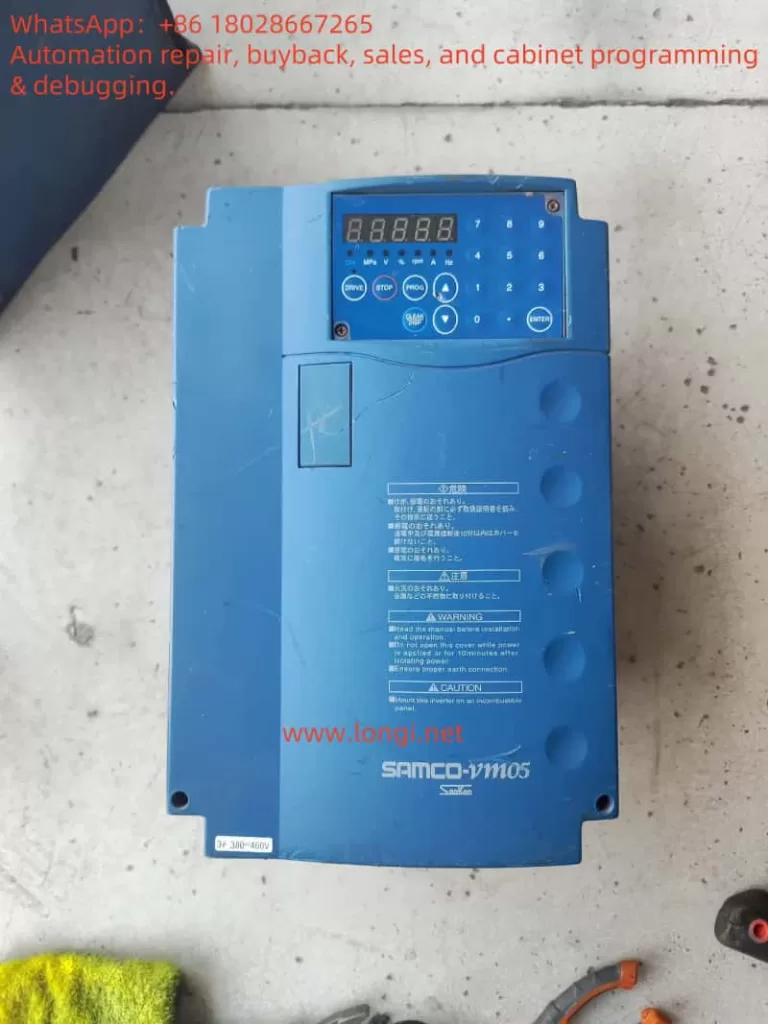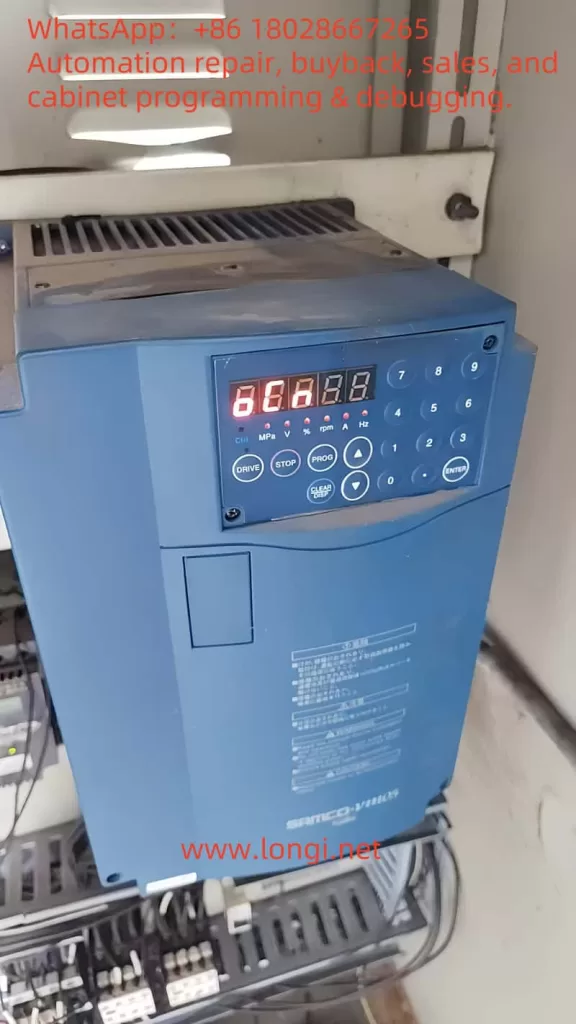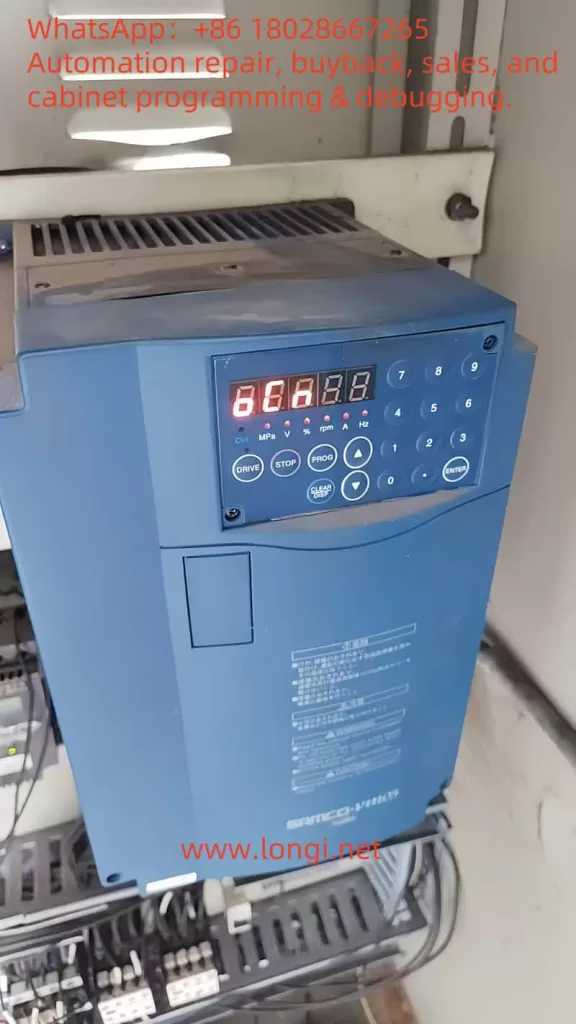Introduction
In the field of industrial automation, Variable Frequency Drives (VFDs) are core devices for controlling the rotational speed of AC motors, widely used in scenarios such as water pumps, conveyor belts, elevators, and machine tools. The Sanken SAMCO-VM05 series inverter is renowned for its compact design, high performance, and low noise characteristics. However, during operation, inverters may encounter faults, with the OCN fault (overcurrent during constant speed) being one of the more common issues. This article will delve into the definition, possible causes, solutions, and preventive measures of the OCN fault, providing users with a clear and practical guide.

What is an Inverter?
An inverter is an electronic device that converts a fixed-frequency power supply into a variable-frequency power supply for precise control of the rotational speed of AC motors. By adjusting the output frequency, inverters enable smooth motor starting, energy-efficient operation, and process optimization. In industrial applications, inverters not only improve equipment efficiency but also extend motor life and reduce maintenance costs.
The Sanken SAMCO-VM05 series inverter is a compact vector control inverter suitable for various industrial scenarios. Its main features include high performance, low noise, and ease of operation, making it particularly suitable for applications such as water pump systems, elevators, and machine tools. However, even high-quality inverters may experience faults due to various reasons, such as the OCN fault.
Definition of the OCN Fault
The OCN fault indicates that the Sanken SAMCO-VM05 inverter detects that the motor current exceeds its rated value during constant speed operation. This fault is typically displayed on the inverter’s control panel as “OCN” or a similar code (e.g., “αCη ※ 3”), prompting operators to take immediate action. Overcurrent can lead to damage to the inverter or motor, making timely diagnosis and resolution crucial.
Based on manuals for similar models (e.g., SAMCO-NS series) and fault code information provided by users, the OCN fault is typically associated with the following issues:
- Output circuit short-circuit or ground fault.
- Abnormal internal switching elements (e.g., IGBTs).
- Excessive or sudden load changes.
- Improper parameter settings.
- Motor faults.
Possible Causes of the OCN Fault
To effectively resolve the OCN fault, it is essential to understand its potential causes. The following are common factors that may lead to overcurrent during constant speed:
1. Output Short-Circuit or Ground Fault
A short-circuit or ground fault in the output circuit can cause a sudden increase in current, triggering the OCN fault. This may be caused by:
- Cable damage, such as broken or exposed insulation.
- Loose or poor connections.
- Insulation failure due to moisture or contamination.
2. Abnormal Internal Switching Elements
Power semiconductor elements (e.g., IGBTs) inside the inverter may fail due to:
- Aging from long-term use.
- Element damage caused by overheating.
- Manufacturing defects.
3. Excessive or Fluctuating Load
If the motor load exceeds its rated capacity or experiences sudden changes, it may cause a current surge. For example:
- Load exceeding the design range of the motor and inverter.
- Mechanical system (e.g., conveyor belt) experiencing jamming or sudden increases in resistance.
4. Improper Parameter Settings
The parameter settings of the inverter directly affect its operational performance. The following setting errors may lead to overcurrent:
- Excessively short acceleration/deceleration times, resulting in high current demand.
- Excessively high current limit value (e.g., Cd043).
- Improper torque compensation settings.

5. Motor Faults
Faults in the motor itself may also trigger the OCN fault, such as:
- Winding damage or short-circuit.
- Increased mechanical resistance due to bearing wear.
- Ground fault caused by motor insulation aging.
Fault Code Table
The following table, compiled based on fault code information provided by users, lists codes related to the OCN fault and their descriptions:
| Fault Code | Description | Check Points |
|---|---|---|
| αCη ※ 3 | Overcurrent during constant speed | Is there an output short-circuit or ground fault? |
| αCη ※ 3 | Overcurrent during acceleration | Is the operation involving abrupt acceleration/deceleration? |
| αCη ※ 3 | Overcurrent during deceleration | Is there an abnormality in the main switching element itself? |
| αCPη | Short-term overload during constant speed | Is the current limit value Cd043 too high? |
Note: The OCN fault corresponds to “overcurrent during constant speed.”
Steps to Resolve the OCN Fault
The following are systematic steps to resolve the OCN fault, aimed at helping users quickly locate and resolve the issue:
1. Check the Output Circuit
Steps:
- Inspect the cable from the inverter to the motor for signs of damage, burns, or exposure.
- Ensure all terminal connections are secure and free from looseness.
- Use a multimeter to check for short-circuits or ground faults in the circuit.
Note: Before inspection, be sure to disconnect the power supply to ensure safety.
2. Verify the Load
Steps:
- Confirm that the motor load is within the rated range.
- Check for sudden load changes, such as mechanical jamming.
- If the load is excessive, consider reducing the load or replacing the motor and inverter with higher-power units.
Note: Load fluctuations may require adjustments to the process flow or the addition of buffer devices.
3. Check the Motor
Steps:
- Visually inspect the motor for physical damage, such as a cracked casing or unusual noises.
- Use an insulation tester to check the motor’s insulation resistance to ensure no ground faults exist.
- If possible, test the motor with another inverter to confirm whether the fault is caused by the motor.
Note: Motor maintenance should be performed regularly to avoid potential issues.
4. Adjust Parameters
Steps:
- Enter the inverter’s parameter setting menu to check the current limit value (e.g., Cd043), acceleration/deceleration times, and torque compensation settings.
- Adjust the parameters according to the load characteristics to ensure they match the application requirements.
- Refer to the recommended settings in the Sanken SAMCO-VM05 manual.
Note: Parameter adjustments should be made cautiously, and it is advisable to record the original settings for restoration if necessary.

5. Check the Cooling System
Steps:
- Inspect the cooling systems of the inverter and motor to ensure that the fans and heat sinks are functioning properly.
- Measure the ambient temperature to ensure it does not exceed the inverter’s rated operating temperature.
- Clean dust and debris to improve ventilation.
Note: Overheating can cause element damage and requires special attention.
6. Reset the Inverter
Steps:
- Turn off the inverter’s power supply and wait a few minutes before restarting it.
- Observe whether the fault disappears. If it does, continue monitoring the system’s operation.
Note: If the fault recurs, further hardware inspection is required.
7. Contact Technical Support
Steps:
- If the above steps fail to resolve the issue, contact Sanken technical support or a professional technician.
- Provide the fault code, system configuration, and the steps you have already attempted to facilitate quick diagnosis.
Note: Internal element faults may require professional repair or replacement.
Preventive Measures
To reduce the occurrence of the OCN fault, the following preventive measures are recommended:
Regular Maintenance:
- Regularly inspect the inverter, motor, and circuit, clean dust, and ensure proper ventilation.
- Check for loose terminal connections and aging cables.
Proper Installation:
- Install the inverter in a dry, clean, and well-ventilated environment.
- Use cables that meet specifications and ensure secure connections.
Appropriate Selection:
- Ensure that the power of the inverter and motor matches the application requirements to avoid overloading.
Parameter Configuration:
- Correctly set parameters according to the Sanken manual and application requirements to avoid faults caused by incorrect settings.
Personnel Training:
- Train operators and maintenance personnel to ensure they are familiar with the operation and fault handling procedures of the inverter.
Conclusion
The OCN fault (overcurrent during constant speed) of the Sanken SAMCO-VM05 series inverter may be caused by various factors, including output short-circuits, load issues, improper parameter settings, or hardware faults. Through systematic inspection and adjustment, users can effectively resolve this issue. Regular maintenance, proper installation, and appropriate parameter configuration are key to preventing faults. If the problem persists, it is advisable to contact Sanken technical support or a professional technician for in-depth diagnosis.
By following the guidelines provided in this article, users can better understand and handle the OCN fault, ensuring the stable operation and long-term reliability of the inverter system.
References
- Sanken SAMCO-NS Series Manual (Reference for Similar Models)
- Fault Code List Provided by Users (Attachment ID: 2)
